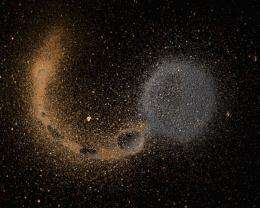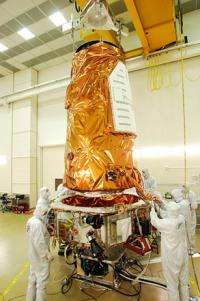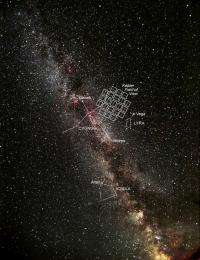Building Planet Earth

A new study shows how rocky planets are formed from the manic swirl of gas and dust that surround a young star, and determines what chemical building blocks are used to construct the planets. Understanding the dynamics and chemistry that create planetary systems can help astronomers in their search for Earth-like planets in the galaxy.
NASA has long followed the water and chemical building blocks of life in the course of space exploration. But most computer simulations that help scientists understand how planetary systems form usually overlooked the chemistry of planets, at least until now.
A new study has looked for the first time at the dynamics and chemistry of how Earth-like planets form. The approach shows how rocky planets form from the manic swirl of gas and dust in the early planetary systems, and also what chemical building blocks existed in the planets that emerged from the chaos.
"If we're looking for Earth-like planets, it'd be nice to know the chemistry we're after," said Jade Bond, a planetary scientist at the University of Arizona in Tucson and a lead author on the study.
Such a first step has only assessed the chemistry of Earth's solar system, and still needs testing across more dynamical models. But eventually Bond and her colleagues hope to also assess the chemistry of exoplanets in orbit around other stars.

Thumbs up to wet planets
Dynamical models usually focus on the physics of interactions that lead to the formation of such rocky planets, and don't examine the chemistry that ends up in planets. At best, some have simulated how meteorites might carry water to planets.
Bond's group wanted to see if dynamical models could also successfully predict the chemical building blocks that make up planets similar to those in Earth's solar system. Toward that end, they used commercial software to analyze the elements that make up the planets, using a 2006 dynamical model by David O'Brien at the Planetary Science Institute in Tucson, Arizona, and colleagues.
The software figured out the starting chemistry of different planets by calculating equilibrium condensation temperatures within the primordial cloud of gas and dust that eventually formed the solar system. Scientists have found that certain temperature profiles reliably match certain chemical profiles, after studying material from meteorites that fell to Earth. Some meteorites still hold the chemical profiles of the early solar system, and can serve as useful real life comparisons for simulations.
Model results showed that Earth and other rocky planets in the solar system formed "wet," with perhaps enough water to sustain life. But important elements such as nitrogen and carbon did not accumulate during simulated planet formation, which suggests that they needed to arrive by other means to kick start the development of life on Earth.
Gas giants such as Jupiter and Saturn appeared to influence how much water material accumulated on terrestrial planets. But gas giant evolution had less effect on the elements that form the rocky layers of such smaller planets, at least after the gas giants had themselves formed and moved out to their current orbits.

Making better worlds
Such early findings seem promising. But the researchers want to extend their chemical analysis across more dynamical models before they feel comfortable about drawing conclusions about exactly how Earth's solar system formed.
"Basically we're trying to get a better sense of how terrestrial planets form, and the processes that we can expect to see," Bond explained. "And we're not only focused on our solar system, but other planetary systems as well."
Bond wants to include many more factors that play a role in how an Earth-like planet's chemical equilibrium takes shape, such as giant planet migrations in the same star system. But she knows that even today's supercomputers have their limits, and so do models that try to simulate how real planets formed.
"To essentially get every aspect of this, get all the dynamics going, track every single particle and every outflow from every collision, adding in chemistry, crossing the ice lines … the computational power is just ridiculous for that," Bond said.
Narrowing the search
Still, the researchers have begun chemically profiling known exoplanet systems with the current simulations. Knowing if many rocky planets form with the proper balance of water and other chemical compounds would go a long way toward understanding whether conditions suitable for life are widespread or not.
Better models could even help focus the search for Earth-like planets by NASA's Kepler Space Telescope and other missions, once chemical profiles for such promising terrestrial planets have become firmly established. But scientific certainty may only come when the researchers can verify their chemical profiles of planets in other dynamical models.
More details on the research appear in the August/September issue of the journal Icarus.
Source: Astrobio.net, by Jeremy Hsu

















